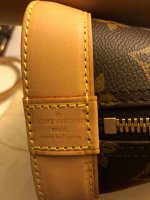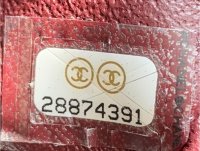Algorithms that can spot features invisible to the human eye are helping to protect retailers and shoppers from a glut of fake goods.

www.wsj.com
When Olivia Matthaei, a consignment store sales clerk, needs to check whether a designer handbag is authentic, she knows the drill. She grabs a custom camera with a microscope lens provided by Entrupy, a New York-based artificial-intelligence startup. The shape of a bulky battery pack, it pops onto an iPhone or iPod. She opens the Entrupy app and selects a brand from a list.
The app guides her through taking photos of different parts of the bag, such as specific areas of the fabric and logo, as she presses the camera against the material. It normally takes a user three to five minutes to go through the authentication process, but she is faster because the store, Opulent Habits, in Madison, N.J., has been using the app since 2018.
“I can do it in less than a minute at this point,” Ms. Matthaei says.
While developing the algorithms behind their tech, Entrupy’s founders spent years collecting authentic and fake bags to teach the algorithm how to tell the difference between the two, down to details that most humans would have a hard time spotting. Entrupy still has stacks of fancy handbags, most of them fakes, surrounding their engineers’ workstations at its Manhattan office, which has been closed since March because of the coronavirus pandemic.
Entrupy’s camera fits onto a phone and magnifies the fabric of a bag, making features invisible to the eye become clear in the resulting images.
PHOTO: JESSICA PETTWAY FOR THE WALL STREET JOURNAL
The lens on Entrupy’s camera magnifies the fabric at least 100 times, making features in the material that are invisible to the eye become clear in the resulting images. Depending on the bag, the AI will check 500 to 1,500 features, such as color, stitching and the pattern of pores in leather. A result pops up in the app in anywhere from 60 seconds to an hour, depending on the brand. With each use, the algorithm becomes a little smarter.
“This is an ideal case for AI,” says Anima Anandkumar, a computer-science professor at California Institute of Technology and director of machine-learning research at chip maker
NvidiaCorp. who wasn’t involved in the development of Entrupy’s app.
Machine learning works by viewing hundreds or thousands of examples, in this case both real and fake bags, and learning to spot what delineates the two.
The technology is
already used in manufacturing to find defects and could be used in a similar way to find counterfeits, says Ms. Anandkumar. Unlike humans, it is able to examine thousands of examples of properly made products and consider billions of data points to find problems, she says.
Today, the process is expensive and time-consuming, not least because it involves collecting real and fake items. In the future, researchers could use AI techniques—such as generative adversarial networks, which create realistic images, or transfer learning, where a model trained to detect one item could train a new model to detect similar items—to speed up the process and bring costs down, says Ms. Anandkumar.
Eventually, the technology could be adapted to other products. Vidyuth Srinivasan, Entrupy’s co-founder and chief executive, wants to expand into verifying industrial goods, electronics, food, medicine and more.
There is a lot to catch. The counterfeit market is worth over $500 billion and makes up around 3.3% of world trade, according to the Organization for Economic Cooperation and Development.
Vidyuth Srinivasan, Entrupy’s co-founder and chief executive, at the startup’s office in New York.
PHOTO: JESSICA PETTWAY FOR THE WALL STREET JOURNAL
Mr. Srinivasan, Ashlesh Sharma and Lakshminarayanan Subramanian started Entrupy in 2012, and spent the next four years collecting data. Entrupy employees bought and returned so many bags that they ended up being blacklisted by some stores, says Mr. Srinivasan. For counterfeits, they would go to China and come back with suitcases full of imitations.
Today, Entrupy’s app can check 15 designer brands, from
Gucci to Chanel. Prices start at $99 a month for up to five checks monthly and go up to tens of thousands of dollars for annual subscriptions that cover hundreds of tests. Entrupy says it has sold about 900 of its cameras to customers in 65 countries, including Dubai’s department of economic development,
eBayInc. and Goodwill Industries International Inc.
Stores pay the fees to protect their reputations with customers and avoid the costs of acquiring counterfeits. In some cases, they can charge more for bags that are authenticated. Forgeries have outsmarted Entrupy’s algorithms about 0.01% of the time, Mr. Srinivasan says. If a customer buys a bag that later turns out to be counterfeit, and the app missed it, the company says it will buy it for the same purchase price.
Gucci and Chanel didn’t respond to requests for comment.
Launched in 2015, the
online sneaker marketplace GOAT uses machine learning to pinpoint counterfeits among the million or so listings that are up at any given time, says CEO Eddy Lu.
Once sellers accept a buyer’s bid for a pair of shoes, they ship them to one of eight GOAT centers around the world. There, AI scans for microscopic deviations in the item, assisting human authenticators who feel, weigh and even smell the shoes. “The glue that
Nike uses is different than what other factories use,” Mr. Lu says.
Eddy Lu, the chief executive of online sneaker marketplace GOAT, at a conference in June 2019. The company uses AI and humans to uncover counterfeit shoes.
PHOTO: DAVID PAUL MORRIS/BLOOMBERG NEWS
If the shoes are real, they are sent to the buyer. GOAT offers to send back or destroy shoes that didn’t pass its tests. AI speeds up the process, but it is impossible to train algorithms to keep up with new shoe styles that debut every week, Mr. Lu says. Eventually each new sneaker gets the AI treatment, but even then, Mr. Lu says, there is no current AI that can replicate all the different checks that the human authenticators look for.
Counterfeit goods also show up on
Amazon, where more than half of physical merchandise sales in 2019 were from
third-party sellers, according to the company.
Last year,
Amazon released Project Zero, an AI-driven anticounterfeiting program for brands that aims to automatically remove bogus goods from the site. Brands provide
Amazon with logos, trademarks and other data, which the AI uses to look for suspected counterfeits among the billions of product listings.
“Amazon strictly prohibits the sale of counterfeit products, and we invest heavily in both funds and company energy to ensure our policy is followed,” Amazon spokeswoman Cecilia Fan said in a statement.
Other online marketplaces have anticounterfeiting measures in place. Shopgoodwill.com, a website set up in 1999 to let Goodwill stores in the U.S. and Canada sell their most lucrative donations online, includes Entrupy certificates with each handbag. The scans let 80 Goodwill locations that use the site list handbags for more money, says Ryan Smith, the senior technology services director at Goodwill of Orange County, which runs the website.
At Opulent Habits, New Jersey’s shutdown order has changed business—the shop now sells its goods curbside. Owner Darcy Ginsberg scans about 60 bags a month and finds a fake about once every four months. That number is lower now that counterfeiters know she is using Entrupy, she says. In 2019, 9.6% of Entrupy scans were fakes, down from 15% in 2017, according to company data.
“It’s a huge confidence booster for customers,” Ms. Ginsberg says. “It puts them at ease.”






